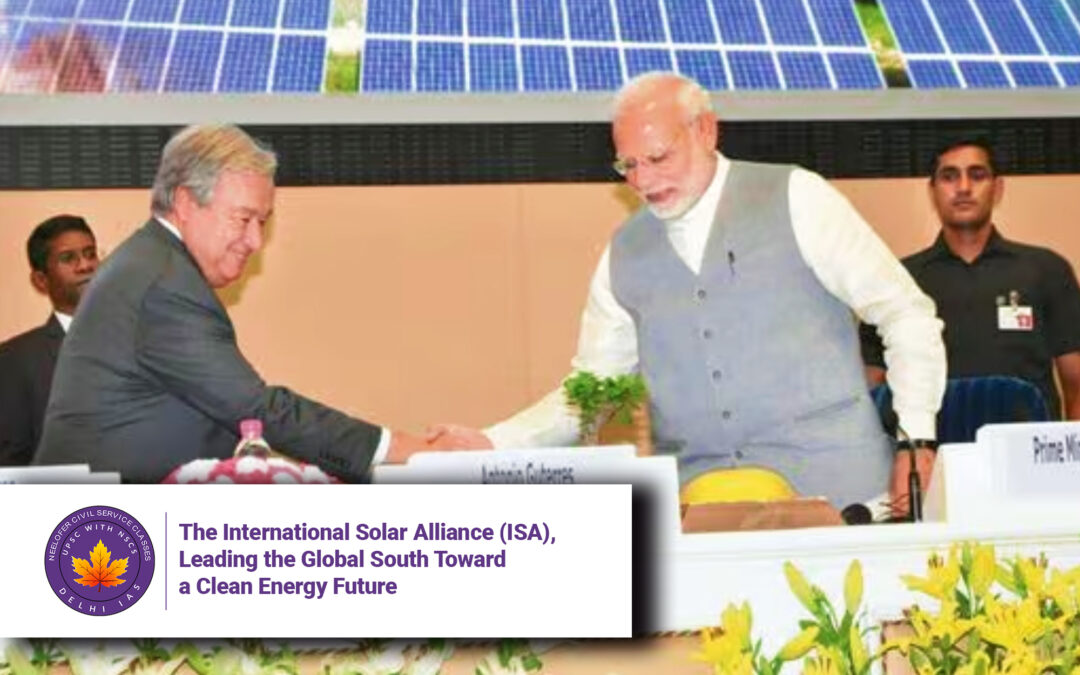The International Solar Alliance (ISA), Leading the Global South Toward a Clean Energy Future
Why in News?
India has achieved a significant milestone in its renewable energy journey, reaching 22 gigawatts (GW) of renewable capacity, with a notable 10 GW from solar energy alone. This growth is part of the global effort championed by the International Solar Alliance (ISA), which is now becoming central to the clean energy transition across the Global South. The ISA’s vision, strengthened under India’s leadership, is poised to drive sustainable development and energy equity worldwide. 
Introduction
In April, India reached 22 GW of renewable energy capacity, with solar power contributing almost half. Under Prime Minister Narendra Modi’s leadership, India has not only increased its domestic solar capacity but has also become a champion for the Global South through the International Solar Alliance (ISA). Established in partnership with France at COP21 in 2015, the ISA now includes 123 member and signatory countries and is rapidly expanding its reach and influence.
Key Themes and Strategic Focus Areas
1. India’s Domestic Solar Success:
India’s solar journey is supported by rapid growth in solar parks, domestic manufacturing, and policy frameworks like the Production Linked Incentive (PLI) Scheme. India’s modular manufacturing capacity now stands at 26 GW, and the cost of solar energy has dropped by 68% between 2014 and 2021.
2. The ISA’s Global Role:
The ISA serves as the primary international platform for cooperation among solar-resource-rich countries. It aims to mobilize $1 trillion in solar investments and build collaborative mechanisms in energy access and climate action.
3. Four Strategic Pillars of ISA:
-
Catalyzing Investments through Risk Mitigation Tools: Instruments like the Global Solar Facility, beginning with a $250 million Africa-focused fund, will mobilize billions in solar financing.
-
Building a Solar Ecosystem: Creation of regional and national centres of excellence to provide local solutions in ten countries by 2030.
-
Scaling Innovations for Deployment: Programs like One Sun One World One Grid and Green Hydrogen showcase ISA’s push for interconnected energy systems.
-
Enabling Infrastructure: A focus on regulatory alignment, skill development, and capacity building ensures faster and fairer energy access.
4. Equity and Energy Access for the Global South:
With 733 million people worldwide lacking electricity access—most of them in Africa and Asia—ISA’s efforts are crucial for sustainable development and energy equity. ISA initiatives are aligned with SDG 7 (Affordable and Clean Energy) and climate goals.
5. India as a Solar Power Leader:
India’s policy innovations and large-scale implementation strategies are now benchmarks for other developing countries. Its initiatives are supporting countries in Africa, Latin America, and the Caribbean to design and deploy clean energy solutions.
Conclusion
The International Solar Alliance stands out as a shining example of multilateral climate action driven by the Global South. With India’s continued leadership and support from global institutions, the ISA is building the frameworks and financial platforms needed to turn the solar dream into a global reality. Clean energy, sustainable infrastructure, and inclusive growth are now within reach for many nations, thanks to ISA’s forward-looking vision and practical roadmap.
Q&A Section
1. Q: What is the International Solar Alliance (ISA)?
A: The ISA is a global intergovernmental organization founded by India and France in 2015 to promote solar energy use, particularly across the Global South. It now includes 123 countries.
2. Q: What are the ISA’s four strategic pillars?
A: The four pillars are: catalyzing investments, building a solar ecosystem, scaling innovation for deployment, and enabling infrastructure.
3. Q: What is the Global Solar Facility?
A: It’s a $250 million Africa-focused solar fund by ISA designed to catalyze solar investments in developing countries, eventually scaling to more than 20 countries.
4. Q: How is India contributing to the global solar movement?
A: India has expanded its domestic solar capacity, created solar parks, invested in manufacturing, and is exporting solar energy frameworks and support to countries across the Global South.
5. Q: What long-term goals does ISA aim to achieve?
A: ISA targets mobilizing $1 trillion in solar investments by 2030, increasing energy access, enabling just transitions, and supporting climate adaptation globally.








